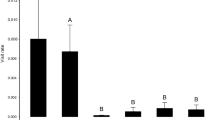Abstract
Female reproductive success (seed set) of a spring ephemeral plant, Corydalis ambigua Cham. et schlecht (Papaveraceae) was investigated in relation to inflorescence size and foraging behavior (frequency and duration of visitations) by pollinators (namely, overwintered queens of Bombus hypocrita sapporensis) by detailed daily observations of a natural population. Pollination experiments indicated that C. ambigua is self-incompatible and that seed set was significantly affected by the behavior of the pollinating queens. Plants with larger inflorescences were visited more often than those with fewer flowers. Fecundity also increased with increasing size of inflorescences. Visitation time (duration of foraging) rather than the frequency of visitations (number of visits) was critical for higher fecundity. Seed production was strongly enhanced by a few long visits (of more than 60 s), and seemed to be independent of large numbers of short visits (of less than 60 s). Hence, plants with larger inflorescences, which provide a conspicuous signal to pollinators and offer greater rewards in terms of nectar, received longer visits by B. hypocrita sapporensis queens and those plants exhibited higher fecundity.
Similar content being viewed by others
References
Ackerman JD (1989) Limitations to sexual reproduction in Encyclia krugii (Orchidaceae). Syst Bot 14: 101–109
Broyles SB, Wyatt R (1990) Plant parenthood in milkweeds: a direct test of the pollen donation hypothesis. Plant Species Biol 5: 131–142
Campbell DR (1989a) Measurements of selection in a hermaphroditic plant: variation in male and female pollination success. Evolution 43: 318–334
Campbell DR (1989b) Inflorescence size: test of the male function hypothesis. Am J Bot 76: 730–738
Cody ML (1966) A general theory of clutch size. Evolution 20: 174–184
Cole FR, Firmage DH (1984) The floral ecology of Plantanthera blephariglottis. Am J Bot 71: 700–710
Cruden R (1977) Pollen-ovule ratios: a conservative indicator of breeding systems in plants. Evolution 31: 32–46
Firmage DH, Cole FR (1988) Reproductive success and inflorescence size of Calopogon tuberosus (Orchidaceae). Am J Bot 75: 1371–1377
Grant V, Grant KA (1965) Flower pollination in the phlox family. Columbia University Press, New York
Harder LD (1982) Measurement and estimation of functional proboscis length in bumblebees (Hymenoptera: Apidae). Can J Zool 60: 1073–1079
Harder LD (1983) Flower handling efficiency of bumble bees: morphological aspects of probing time. Oecologia 57: 274–280
Harper JL (1977) Population biology of plants. Academic Press, London
Heinrich B (1975) Energetics of pollination. Annu Rev Ecol Syst 6: 139–170
Higashi S, Ohara M, Arai H, Matsuo K (1988) Robber-like pollinators: overwintered queen bumblebees foraging on Corydalis ambigua. Ecol Entomol 13: 411–418
Hodges CM, Wolf LL (1981) Optimal foraging in bumblebees: why is nectar left behind in flowers? Behav Ecol Sociobiol 9: 41–44
Janzen DH, De Vries P, Glandstone DE, Higgings ML, Lewisohn TM (1980) Self- and cross-pollination of Encyclia cordigera (Orchidaceae) in Santa Rosa National Park, Costa Rica. Biotropica 12: 72–74
Kawano S (1975) The productive and reproductive biology of flowering plants. II. The concept of life history strategy in plants. J Coll Liberal Arts, Toyama Univ 8: 51–86
Montalvo AM, Ackerman JD (1987) Limitations to fruit production in Ionopsis utricularioides (Orchidacea). Biotropica 19: 24–31
Ohwi J (1975) Flora of Japan. Shibundo, Tokyo
Rodriguez-Robles JA, Melendez EJ, Ackerman JD (1992) Effects of display size, flowering phenology, and nectar availability on effective visitation frequency in Comparettia falcata (Orchidaceae). Am J Bot 79: 1009–1017
Sakagami SF (1951) Einige Beobachtungen über den Blumenbesuch der Hummeln. Insectes Soc 3: 75–80
Schemske DW (1980) Evolution of floral display in the orchid Brassavola nodosa. Evolution 34: 489–493
Schmid-Hempel P, Speiser B (1988) Effects of inflorescence size on pollination in Epilobium angustifolium. Oikos 53: 98–104
Shaffer WM, Shaffer MV (1979) The adaptive significance of variations in reproductive habit in the Agavaceae. II. Pollinator foraging behavior and selection for increased reproductive expenditure. Ecology 60: 1051–1069
Shannon TR, Wyatt R (1986) Reproductive biology of Asclepias exaltata. Am J Bot 73: 11–20
Sokal RR, Rohlf FJ (1981) Biometry, 2nd edn. Freeman, San Francisco
Solbrig OT, Rollins RC (1977) The evolution of autogamy in species of the mustard genus Leavenworthia. Evolution 31: 265–281
Stephenson AG (1979) An evolutionary examination of the floral display of Catalpa speciosa (Bignoniaceae). Evolution 33: 1200–1209
Sutherland S (1987) Why hermaphroditic plants produce many more flowers than fruits: experimental tests with Agave mckelveyana. Evolution 41: 750–759
Thomson JD (1986) Pollen transport and deposition by bumble bees in Erythronium: influences of floral nectar and bee grooming. J Ecol 74: 329–341
Thomson JD (1988) Effects of variation in inflorescence size and floral rewards on the visitation rates of traplining pollinators of Aralia hispida. Evol Ecol 2: 65–76
Thomson JD, Plowright RC (1980) Pollen carryover, nectar rewards, and pollinator behavior with special reference to Diervilla lonicera. Oecologia 46: 68–74
Thomson JD, Maddison WP, Plowright RC (1982) Behavior of bumble bee pollinators of Aralia hispida Vent. (Araliaceae). Oecologia 54: 326–336
Udovic D (1981) Determinants of fruit set in Yucca whipplei: reproductive expenditure vs. pollinator availability. Oecologia 48: 389–399
Willson MF, Price PW (1977) The evolution of inflorescence size in Asclepias (Asclepiadaceae). Evolution 31: 495–511
Willson MF, Rathcke BJ (1974) Adaptive design of the floral display in Asclepias syriaca L. Am Midl Nat 92: 47–57
Willson MF, Miller LJ, Rathcke BJ (1979) Floral display in Phlox and Geranium: adaptive aspects. Evolution 33: 52–63
Wolf LM (1987) Inflorescence size and pollinaria removal in Asclepias curassavica and Epidendrum radicans. Biotropica 19: 86–89
Wyatt R (1980) The reproductive biology of Asclepias tuberosa. 1. Flower number, arrangement, and fruit-set. New Phytol 85: 119–131
Wyatt R (1982) Inflorescence architecture: how flower number, arrangement, and phenology affect pollination and fruit-set. Am J Bot 69: 585–594
Author information
Authors and Affiliations
Rights and permissions
About this article
Cite this article
Ohara, M., Higashi, S. Effects of inflorescence size on visits from pollinators and seed set of Corydalis ambigua (Papaveraceae). Oecologia 98, 25–30 (1994). https://doi.org/10.1007/BF00326086
Received:
Accepted:
Issue Date:
DOI: https://doi.org/10.1007/BF00326086




